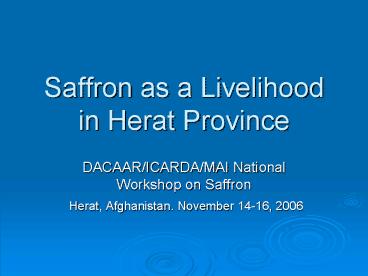Saffron as a Livelihood in Herat Province - PowerPoint PPT Presentation
1 / 11
Title:
Saffron as a Livelihood in Herat Province
Description:
28 of the 31 families reported growing some area of saffron. ... collected by Hashim Aslami (DACAAR) and Peter Wyeth (Washington State University) ... – PowerPoint PPT presentation
Number of Views:113
Avg rating:3.0/5.0
Title: Saffron as a Livelihood in Herat Province
1
Saffron as a Livelihood in Herat Province
- DACAAR/ICARDA/MAI National Workshop on Saffron
- Herat, Afghanistan. November 14-16, 2006
2
Income from crops is crucial to many families.
- 28 of the 31 families reported growing some area
of saffron. - 16 of 31 families said their only livelihood was
from growing crops. - 5 were also laborers
- 10 had other professions, e.g. teachers
3
Saffron farmers are found among those who farm
large amounts of land and those who farm little.
4
What income can they make?
- Data on revenues and costs of saffron production
collected from farmer groups in Pashtun Zarghun - (Hashim Aslami and Peter Wyeth).
- Resulting figures are an approximation - will be
revised over time.
5
Method for calculating net returns to saffron
- Saffron being perennial, estimate revenues and
costs over full life cycle (5 to 7 years). - People value any benefit received soon more than
the same benefit received later. (They prefer
Afs 10,000 now to Afs 10,000 received in a year) - Similarly current costs are weighed more heavily
than future costs of the same amount.
6
Method for calculating net returns to
saffron(continued)
- This tendency to reduce the value of future
amounts is called discounting. In economics we
take account of it by reducing future amounts
using a discount rate.
7
Method for calculating net returns to saffron
(continued)
- Add up the discounted revenues for all years in
the saffron production cycle (say 5) - Do the same for costs.
- Net Present Value (NPV) is
- Total Discounted Revenue
- minus
- Total Discounted Cost
8
Method for calculating net returns to saffron
(continued)
- Because investment costs are immediate and
revenues commonly build up in later years,
revenues are more heavily discounted than costs. - Consequently, most projects look better at low
discount rates than high ones.
9
Method for calculating net returns to saffron
(continued)
- No firm rule for picking a discount rate exists.
Common to use several. If a project is viable at
a range of discount rates, it is promising. - When comparing net returns for saffron and other
crops, treat other crops in the same way, even if
they are annuals. - If saffron replaces two crops per year, compare
with the sum of their net returns.
10
Net Present Values Saffron and other crops
Figures from group interviews, Pashtun Zarghun,
collected by Hashim Aslami (DACAAR) and Peter
Wyeth (Washington State University)
11
Conclusions
- Saffron is more profitable than other crops in
the table (besides poppy), at all rates of
discount (assuming good markets can be found). - Farmers of all sizes will benefit.































